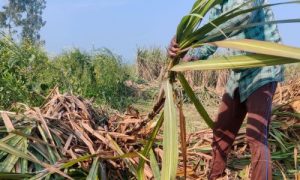The bitter truth of quickie gate-cane weddings in Marathwada’s sugar belt

In Beed district, the Thorat family’s youngest daughter, Manisha, married at 18, unlike her five older sisters who wed at 15 and became sugarcane field laborers, or “koytas.” This practice, known as “gate-cane” weddings, often leads to child marriages driven by economic pressures. Despite efforts to prevent these marriages, they persist due to significant financial incentives. Researcher Reetika Subramanian highlights the link between drought, labor demands, and early marriages in Marathwada.
It was a big fat affair when the Thorat family in ‘s Beed district decided to get their youngest daughter Manisha married in a departure from the unceremonious weddings of their five older daughters.
Unlike her sisters who were wedded at 15, Manisha tied the knot at 18, a milestone for a family where marriages had become a quickie clandestine affair before the couple was ushered into sugarcane fields as a newly-minted ‘koyta’, a Marathi word for the ‘sickle’ used for hacking crops which holds deeper meaning in drought-prone districts of Marathwada.
It’s a term for couples hired as a single labour unit to work as seasonal cane cutters in Maharashtra and Karnataka by ‘mukadams’, who play the dual role of a contractor and matchmaker.
The practice colloquially called ‘gate-cane’ weddings, seems to have various origins. Some attribute it to the tradition of marriages solemnised at the gates of sugar mills or just before the harvest. Others link it to halting a sugarcane cart at the factory gate.
Regardless, the ‘koyta padhhati’ or couple arrangement is seen by the sugarcane industry as a quick solution to its labour needs. For cane cutters, the lump sum advance called ‘uchal’ of Rs 1 lakh for each koyta is an amount seldom matched by other jobs in the region.
However, this ‘shortcut’ marriage-based labour setup has fueled child marriages. Families feel pressured to marry off their adolescent daughters rather than leaving them behind as they go for cane cutting, whereas boys’ families try to boost their earnings by expanding their koyta workforce.
In a rare instance, Manisha, found a protector in her elder sister Jyoti. “I’ve experienced the scars of being married off at 15, followed by backbreaking work even while pregnant. My sons were born premature,” says Jyoti. Now 26, she’s determined to shield Manisha from a similar fate or that of their mother’s, who underwent unwarranted hysterectomy common among Maharashtra’s female sugarcane cutters.
However, despite efforts by village authorities to crack down on child marriages by roping in priests, tent owners, music bands, decorators, caterers and card printers, these gatecane weddings remain difficult to detect or prevent.
In a recently published paper titled ‘Gate-Cane: (Un)tying the knots between climate, cane, and early marriage in rural India’, Reetika Subramanian, a Gates-Cambridge scholar at the University of Cambridge Centre for Gender Studies and founder of the ‘Climate Brides’ podcast, documents the phenomenon of ‘gate-cane weddings’ in Marathwada and how it affects young girls.
“I looked at links between cyclical droughts, labour arrangements in the sugarcane industry and the well-oiled machinery which is producing early marriages and younger wives,” explains Subramanian who researched three districts of Beed in Marathwada, trailing the sugarcane-cutting season between September 2020 and 2021.
“Everyone knew ‘gate-cane’ weddings were happening in their region,” recounts Subramanian after attending meetings of the child marriage prohibition committees convened by the Beed district collectorate. “Yet, they were unsure of what they could do since earnings from these marriages were part of their economy.”
A mix of motivations drive the gate-cane weddings with multiple members often joining as separate koytas from the same household. “The lure is the hefty advance that each koyta receives, especially after a dry season where local livelihoods are scarce. This money helps them manage their households, arrange weddings, and cover medical expenses,” says Raju Sathe, a co-ordinator with Sankalp Manav Vikas Sanstha, working with marginal farmers in many districts.
“Plus, these weddings are low-budget, costing around Rs 10,000, compared to traditional weddings that can hit Rs 2.5 lakh,” adds Sathe, explaining why they’re often termed ‘one-day match’ or ‘jhatpat shaadi’. Limited schooling options beyond class eight is another factor, he says.
Subramanian agrees that the age range of those wedded into the gate-cane system are usually girls between 14 to 17 years, coinciding with the end of their entitlement to free and compulsory education under the RTE Act. “It’s a clear trajectory into the workforce. According to the sarpanch of Danemoha village in Dharur, about 75% of marriages are child marriages,” she says. While most underage teenagers being married off into the koyta system are girls, around 25% are boys, points out Sathe.
While the koyta system helps these families with quick cash, it also traps them in debt. “These advances are upfront but come with interest, which these mukaddams and sugar mills keep reaping until the money is recovered. If the debt remains unpaid, they’re called back to work the next year. This prompts many to marry off their teens to form new koytas for a fresh advance,” explains Sathe. Mukadams often broker such marriages and even cover expenses, as they receive a commission for every new koyta they recruit, adds Beed activist Tatwashil Kamble.
















